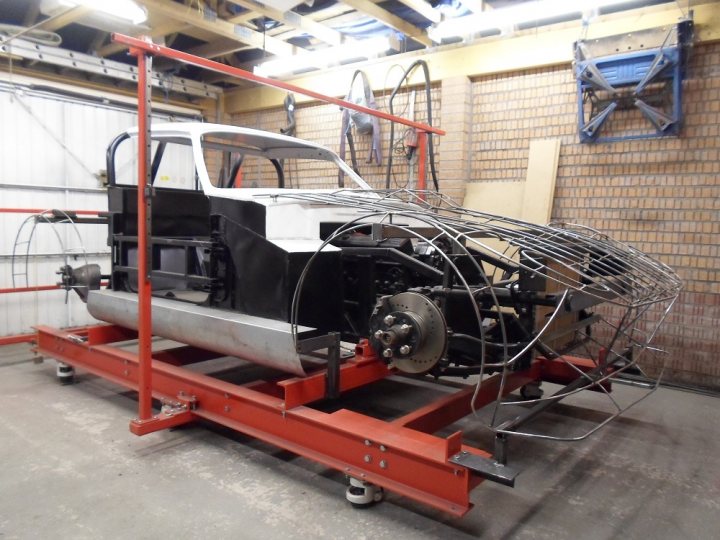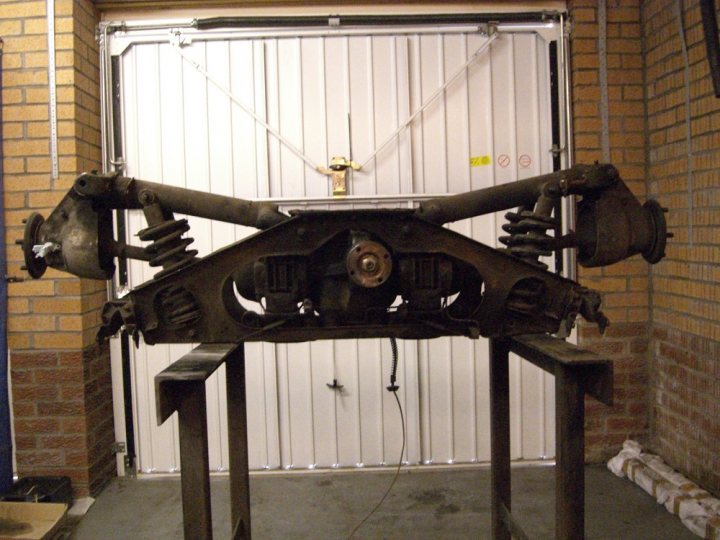Look at what this guy is doing.
He's definitely more ambitious than a locost and he lays it out there step by step. Ignore all the comments and just look at his posts and his pics. You'll be amazed.
In one way he's not overly ambitious, but in another all the little details you have to work out makes any task like this quite ambitious.

Sorry I wasn't through editing when you posted Aussiemg
Linky
Sure. I didn't need to get anything done at work tonight.
Is it just me or is all that square tube in the backbone 0.125 or 0.188 wall? That seems way overkill.
ditchdigger wrote:
Is it just me or is all that square tube in the backbone 0.125 or 0.188 wall? That seems way overkill.
I noticed that as well. It seems like he's in the U.K., so I imagine it rot down to half that thickness in a few short months.
That thing is gunna weigh 4k lbs! That said, it's always nice to see someone building their vision.
Thanks. This is very inspirational
Warren v wrote:
That thing is gunna weigh 4k lbs! That said, it's always nice to see someone building their vision.
Yeah... making strong is easy, making strong AND light is really hard.
Makes you appreciate what the OEMs can do with 22-gauge and a few well-placed folds and creases.
the dude has got some skills
I can see this build thread is going to eat up big chunks of my time, but I gotta say, so far it looks like he's going through a lot of effort to build a hardtop Maxton Rollerskate.
He's shooting for 2800# so that's pretty light for a fully configured street car with a V8.
He's even got crash bumpers so there are any number of ways he could go to keep the weight down, but he's got to pass some pretty stiff tests to be allowed to drive it on the road over there.

RossD
PowerDork
9/4/13 10:45 a.m.
It said in the first post: Scotland. But a 'GM 400' for a transmission... that sucks.
Never saw a jag rear end with the inboard brakes, looks messy.
benzbaronDaryn wrote:
Never saw a jag rear end with the inboard brakes, looks messy.
I remember seeing it used on a Datsun 510 build from a few years ago, not really sure what the advantage is.
benzbaronDaryn wrote:
Never saw a jag rear end with the inboard brakes, looks messy.
?? On every IRS equiped Jag up until the XJ40, survived on the XJS until the mid 90's, millions of them out there.
This is what I'm talking about.

It just looks complicated verses the more traditional axle assembly used in a mercedes r107. The jag rear end looks compact but also heavy but hell if I know.
benzbaronDaryn wrote:
This is what I'm talking about.
 It just looks complicated verses the more traditional axle assembly used in a mercedes r107. The jag rear end looks compact but also heavy but hell if I know.
It just looks complicated verses the more traditional axle assembly used in a mercedes r107. The jag rear end looks compact but also heavy but hell if I know.

The Mercedes rear end is a semi trailing arm unit. Kind of a swingaxle with a few tweaks and as such doesn't have the best camber curve and will change toe during movement. It has been used with great success by most european marques but has a few design flaws.
The Jag unit is a double wishbone setup but they use the axles as the upper arm. It has its own flaws but the camber curve is predictable and somewhat tuneable and it will not generate odd toe movement like a semi trailing will.
Semi trailing also requires more space forward where the occupants will be in his design.
The Jag rear ends are also easy and cheap to come by in the UK, which makes them the preferred choice of at least the old(er) school hotrodders over there.

jmc14
Reader
9/4/13 5:05 p.m.
Thanks for posting this. I respect anyone that builds their dream car.
Thanks for the information, the Jag rear diff/axle assembly is definitely compact verses the mercedes rear end. I'm sure XJS parts are cheap, I think old jags are like old mercedes in that they aren't worth fixing unless you do it yourself so many get scrapped out. Maybe the fact the axle assembly/differential is upside down got me more confused than regular.
Thanks again folks, I'm getting a bit less ignorant.
The Jag rearend design is garbage. All lateral AND longitudinal location is done by a single link. Toe changes aplenty when the bushings allow it to move around. There's a reason it was only ever used in fairly low-powered cars. I strongly suspect that the real reason that they went with inboard brakes is that the upright-on-a-stick wouldn't cope with the twisting loads that the brake caliper would put on it, so they put the calipers on the rearend.
I AM glad to see that he fixed what I feel is the worst flaw in the front suspension. The upper control arm has extremely little support as-produced. Hand pressure on the tire, such as when checking for wheel bearing or ball joint play, can flex the frame a quarter inch! I'd hate to see what it does with actual loads on it.
A less charitable person would say that the suspension's design is entirely satisfactory for its intended application: a car that spends most of its time inoperable and sulking in a garage.

Knurled wrote:
The Jag rearend design is garbage. All lateral AND longitudinal location is done by a single link. Toe changes aplenty when the bushings allow it to move around. There's a reason it was only ever used in fairly low-powered cars. I strongly suspect that the real reason that they went with inboard brakes is that the upright-on-a-stick wouldn't cope with the twisting loads that the brake caliper would put on it, so they put the calipers on the rearend.
I AM glad to see that he fixed what I feel is the worst flaw in the front suspension. The upper control arm has extremely little support as-produced. Hand pressure on the tire, such as when checking for wheel bearing or ball joint play, can flex the frame a quarter inch! I'd hate to see what it does with actual loads on it.
A less charitable person would say that the suspension's design is entirely satisfactory for its intended application: a car that spends most of its time inoperable and sulking in a garage.
Good thing we have your charitable self to tell us how it should have been done.















































